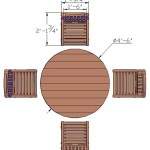Great Landscaping Ideas: Patio Design
A well-designed patio serves as a focal point for outdoor living, seamlessly blending the comfort of interior spaces with the natural beauty of the surrounding landscape. It's an extension of the home, a place for relaxation, entertainment, and connecting with nature. The ideal patio design considers various factors, from the available space and the architectural style of the house to the desired functionality and the homeowner's personal preferences. This necessitates a thoughtful approach to material selection, layout planning, and the incorporation of landscaping elements.
Effective patio design transcends merely placing furniture on a paved surface. It requires a holistic understanding of how different aspects of landscaping can contribute to a cohesive and inviting outdoor environment. Plants, hardscaping features, water elements, and lighting choices all play crucial roles in shaping the patio's atmosphere and its overall appeal.
A truly great patio design not only enhances the aesthetic value of the property but also increases its functionality and value, creating a space that complements the homeowner's lifestyle and enhances their enjoyment of the outdoors.
Planning and Design Considerations
Before embarking on any patio project, a thorough planning phase is essential. This involves considering various factors that will impact the final design, ensuring that the patio meets the homeowner's needs and integrates seamlessly with the existing landscape. This planning process must balance aesthetic preferences with practical considerations.
The size and shape of the patio should be determined by the available space and the intended use of the area. A small patio might be suitable for intimate gatherings, while a larger patio can accommodate larger groups and more elaborate furniture arrangements. Consider the flow of traffic from the house to the patio and around the surrounding landscape. A well-defined pathway can help guide guests and prevent damage to garden beds.
Furthermore, the architectural style of the house should be considered to ensure that the patio design complements the existing structure. A modern home might benefit from a minimalist patio design with clean lines and contemporary materials, while a traditional home might be better suited for a more rustic patio with natural stone and classic furniture. The overall design should reflect a unified aesthetic.
Privacy is another critical consideration, particularly for patios located in urban or suburban areas. Hedges, trees, and fences can be used to create a sense of seclusion and block unwanted views. Strategically placed screens or trellises can also provide privacy without completely obstructing sunlight or airflow. The orientation to the sun and prevailing winds should also be factored in. Ideally, a patio should receive ample sunlight during the day but also offer some shade during the hottest hours. Consider the placement of trees or the installation of a pergola to provide shade. Windbreaks can also be used to protect the patio from strong winds.
Budget constraints are always a significant factor in any landscaping project. It's important to establish a realistic budget early on and to prioritize the most important features. Material costs, labor charges, and any necessary permits should all be factored into the budget. Be prepared to make compromises if necessary, but avoid cutting corners on essential structural elements.
Finally, local building codes and regulations should be consulted before starting any construction. Some areas may have restrictions on patio size, setbacks from property lines, or the use of certain materials. Ensure compliance with all applicable regulations to avoid potential fines or delays.
Material Selection and Hardscaping
The choice of materials for a patio plays a critical role in its both functionality and aesthetics. Different materials offer varying levels of durability, maintenance requirements, and visual appeal. Careful consideration of these factors is essential to ensure that the patio is both beautiful and long-lasting.
Natural stone is a popular choice for patios due to its durability, natural beauty, and ability to blend seamlessly with the surrounding landscape. Options include flagstone, slate, limestone, and granite. Each type of stone has its own unique characteristics and color variations. Flagstone, for example, is known for its irregular shapes and rustic appearance, while slate is prized for its smooth surface and elegant color palette. Natural stone is generally more expensive than other patio materials, but its longevity and aesthetic appeal make it a worthwhile investment.
Concrete pavers are a more affordable alternative to natural stone. They are available in a wide range of colors, shapes, and sizes, allowing for a high degree of design flexibility. Concrete pavers can be designed to mimic the appearance of natural stone, brick, or other materials. They are also relatively easy to install and maintain. Pavers are a durable and versatile option for patios of all sizes.
Brick is a classic patio material that offers a timeless and elegant look. It is durable, fire-resistant, and relatively low-maintenance. Brick patios can be laid in a variety of patterns, such as herringbone, running bond, or basketweave. The color and texture of the brick can be chosen to complement the architectural style of the house and the surrounding landscape. Brick is a good choice for traditional homes and gardens.
Gravel is an inexpensive and versatile patio material. It is easy to install and maintain, and it provides good drainage. Gravel patios are often used in informal garden settings. Different types of gravel are available, including pea gravel, crushed stone, and decomposed granite. The choice of gravel will depend on the desired look and feel of the patio.
Besides the primary surface material, other hardscaping elements can enhance a patio design. Retaining walls can be used to create level surfaces on sloping sites or to define different areas within the patio. Fire pits can provide warmth and ambiance on cool evenings. Outdoor kitchens can create a functional space for cooking and entertaining. Seating walls can provide additional seating and define the perimeter of the patio.
Proper drainage is essential to prevent water from pooling on the patio surface. A slight slope should be incorporated into the design to allow water to run off the patio and into a designated drainage area. French drains or other drainage systems can be used to manage excess water.
Landscaping and Plant Integration
The integration of landscaping elements is crucial for creating a patio that feels like a natural extension of the surrounding garden. Plants can soften the hard edges of paving materials, provide shade and privacy, and add color and texture to the outdoor space. A thoughtful selection of plants can transform a bare patio into a lush and inviting oasis.
Trees can provide shade and privacy, as well as add vertical interest to the patio design. Deciduous trees offer shade during the summer months and allow sunlight to penetrate during the winter. Evergreen trees provide year-round privacy and screening. The size and shape of the tree should be chosen to complement the size of the patio and the surrounding landscape. Consider the mature size of the tree to ensure that it does not outgrow the space.
Shrubs can be used to define the perimeter of the patio, create privacy screens, or add texture and color to the landscape. Flowering shrubs can provide seasonal blooms, while evergreen shrubs offer year-round greenery. Choose shrubs that are well-suited to the local climate and soil conditions. Consider the mature size and shape of the shrubs to avoid overcrowding the patio.
Flowers can add color and beauty to the patio design. Annual flowers provide instant color, while perennial flowers offer long-lasting blooms. Choose flowers that bloom at different times of the year to ensure a continuous display of color. Container gardening is a great way to add flowers to a patio. Pots and planters can be used to create a variety of displays, from simple arrangements to elaborate compositions. Container gardens can also be easily moved around to change the look of the patio.
Groundcovers can be used to fill in gaps between paving stones or to create a soft, natural border around the patio. Groundcovers can also help to suppress weeds and reduce maintenance. Choose groundcovers that are low-growing and drought-tolerant. Creeping thyme, sedum, and creeping jenny are popular choices for patio groundcovers.
Vertical gardening is a great way to add greenery to a small patio. Trellises, arbors, and living walls can be used to create vertical displays of plants. Climbing vines, such as clematis and wisteria, can be trained to grow on trellises or walls. Hanging baskets can also be used to add greenery to vertical surfaces. Vertical gardens can create a sense of enclosure and privacy, as well as add visual interest to the patio.
Consider the use of herbs and vegetables in the patio garden. Herbs can be grown in containers or in raised beds. They are easy to care for and provide fresh ingredients for cooking. Vegetables can also be grown in containers or in raised beds. A small vegetable garden can provide a source of fresh produce for the homeowner.
Lighting and Ambiance
Strategic lighting is essential to extend the usability of a patio into the evening hours and to create a warm and inviting atmosphere. The right lighting can transform a patio from a functional outdoor space into a magical and enchanting retreat. Different types of lighting can be used to create different effects, from soft and romantic to bright and functional.
String lights are a popular choice for patios because they are inexpensive and easy to install. They can be strung across the patio, around trees, or along fences to create a festive and inviting atmosphere. String lights are available in a variety of styles, from traditional incandescent bulbs to energy-efficient LED lights.
Path lighting can be used to illuminate walkways and steps, making it safer to navigate the patio at night. Path lights are available in a variety of styles, from low-voltage lights to solar-powered lights. Choose path lights that are durable and weather-resistant.
Spotlights can be used to highlight specific features of the patio, such as trees, shrubs, or architectural details. Spotlights can also be used to create dramatic shadows and highlights. Choose spotlights that are adjustable so that you can direct the light where you need it.
Uplighting can be used to illuminate trees and shrubs from below, creating a dramatic and ethereal effect. Uplights can also be used to highlight the texture and form of architectural features. Choose uplights that are durable and weather-resistant.
Downlighting can be used to provide general illumination for the patio. Downlights can be mounted on trees, buildings, or pergolas. Choose downlights that are energy-efficient and provide a soft, diffused light.
Consider the use of lanterns and candles to create a warm and romantic atmosphere. Lanterns and candles can be placed on tables, shelves, or hanging from trees. Choose lanterns and candles that are appropriate for outdoor use.
A fire pit or outdoor fireplace can provide warmth and ambiance on cool evenings. Fire pits and fireplaces can be fueled by wood, gas, or propane. Choose a fire pit or fireplace that is safe and easy to use.
Motion-sensor lights can be used to provide security lighting for the patio. Motion-sensor lights will turn on automatically when motion is detected, deterring intruders and providing added safety.
Finally, a well-designed patio should incorporate an outdoor sound system. Speakers can be placed strategically around the patio to provide background music or to create a more immersive audio experience. Choose speakers that are weather-resistant and designed for outdoor use.

Backyard Landscaping Ideas Garden Design

50 Backyard Ideas For A Beautiful Landscape

Patio Design Ideas Garden Gate

Backyard Ideas Landscape Design Landscaping Network

Patio Design Ideas Landscaping Around Backyard Designs Outdoor Decor

40 Stunning Landscape Design Ideas Tips

Backyard Landscaping Ideas Garden Design

Amazing Garden Ideas Design Backyard Patio

53 Landscaping Ideas For Any Budget Backyard Front Yard

The 70 Best Backyard Patio Ideas For 2024 And Beyond
Related Posts








